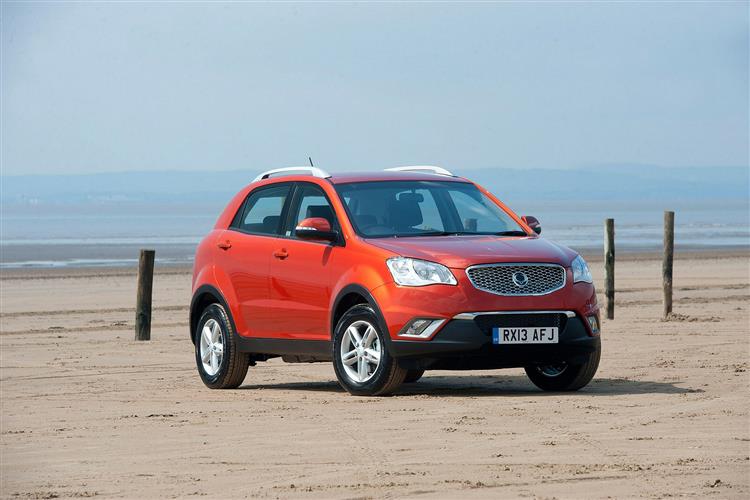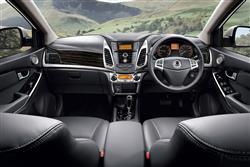This is a sample, showing 30 seconds of each section.
A KOREAN THAT CAN (some text hidden) SECTIONED_new_ssangyongkorando_2014
By Jonathan Crouch
Introductionword count: 120
The Korando was the first really credible car that SsangYong brought us, launched in 2011 to compete as a more affordable alternative in the market for compact SUVs and family-sized Crossovers. It offered lusty torque from its 2.0-litre eXDi diesel engine and the option of more 4WD ability than you'd usually expect from a car of this class. To improve this model's sales momentum, SsangYong facelifted it in 2013 to create the version we're going to look at here as a potential used car buy, this variant lasting until 2015 when the brand introduced its slightly more powerful and efficient 2.2-litre engine. If you're shopping in this segment, is this a contender you should be seriously considering? Let's find out.
Modelsword count: 13
5 dr compact 4x4 (2.0 diesel [S, SE, RLX - 2WD & 4WD])
Historyword count: 129
Remember the old Korando of the Nineties? Probably not - and that's just as well: it was a distinctly unlovely thing. The very different Korando model launched in 2011 was a much more class-competitive thing, with smart Giugiaro styling and a competitive 2.0-litre diesel engine. Most importantly, it was the first of the Korean brand's models to feature a car-like monocoque chassis for reasonable tarmac handling. Sales were modest to start with, despite the fact that this was a Toyota RAV4-style vehicle for up to £10,000 less. Still, things picked up as SsangYong's UK dealer network expanded. Here, we're looking at the facelifted version that launched in 2013 and sold until the brand further revised the range with a larger 2.2-litre diesel engine in late 2015. What You Pay
What You Getword count: 544
This modern era Korando wasn't only the first SsangYong to feature more car-like monocoque underpinnings. It was also the first one with styling you'd really be quite pleased to see on your driveway. For this, the South Koreans had 'Il Maestro', Giorgetto Giugiaro to thank, a man known as one of the great automotive stylists of his generation and responsible for designs as diverse and enduring and the DeLorean and the Fiat Panda. In the clean, sculpted look of the original version of this car, there was certainly evidence of the master's deft touch and this updated model doesn't deviate too far from that, simply modernising the look with sleek projector headlamps and LED daytime running lights framing a reshaped black grille and lower air intakes. SsangYong hopes it's enough to create a sharper, more contemporary look. Get up close and personal and you'll notice the squat stance, beefy wheel arch bulges and sharply rising belt line carrying through to a smart tailgate that also features LED lighting. Lifting it reveals 486-litres, which is usefully more than you'd get in a Nissan Qashqai or Hyundai ix35 from this era. If you need more, then pushing forward the 60/40 split-folding rear bench reveals 1,312-litres. Take a seat at the wheel and you'll find yourself in a reasonably smart interior with sharp, angular styling quite reminiscent of the far pricier Hyundai Santa Fe, which is no bad thing. SsangYong has also taken note of the way its Korean competitor brands have been better using aluminium-look trim and soft-touch plastics and the result, providing you can overlook the artificial wood trim, is a far more inviting cabin than that of the original model. You might not think you were in a much more expensive Sportage or a Qashqai but it's certainly a world away from the Bulgarian thrift store feeling you get sat in a Dacia Duster, the only other car in this segment able to approach this Korando's asking price. Storage is reasonably ample with a practically-sized central cubby and decently shaped side door pockets. The stereo system's built into the dash with a standard set-up that's much easier to use than the fiddly Kenwood DAB system that top-spec variants offered with or without satnav. Getting comfortable at the wheel isn't a problem thanks to a height-adjustable driver's seat and a reach and rake-adjustable steering wheel. Plus, thank goodness, there's a proper conventional handbrake, rather than one of those fiddly electric button ones. The build quality feels reasonable and though there are still a few more hard plastics than you'll find on many more city-orientated rivals, these do feel better suited to a tough and durable life. Whatever your feeling is on that, you certainly can't argue with the amount of rear seat space on offer. This is the only car in this class (premium brand models included) able to comfortably transport three fully-sized adults on the back seat for any distance - long journeys helped by the fact that the seat backs recline, while the seats themselves are even heated on top models. Rear legroom is quite plentiful, aided for the passenger in the middle of the rear seat by the fact that, unlike many of its rivals, this car has no bulky transmission tunnel.
To see the full road test text contact us on 0330 0020 227
Pictures (high res disabled)

.jpg)
|
.jpg)
|
.jpg)
| |||
.jpg)
|
.jpg)
|

|
Scoring (subset of scores)
Category: Crossover or SUV 4x4s
| Performance | |
| Handling | |
| Comfort | |
| Space | |
| Styling, Build, Value, Equipment, Depreciation, Handling, Insurance and Total scores are available with our full data feed. | |



